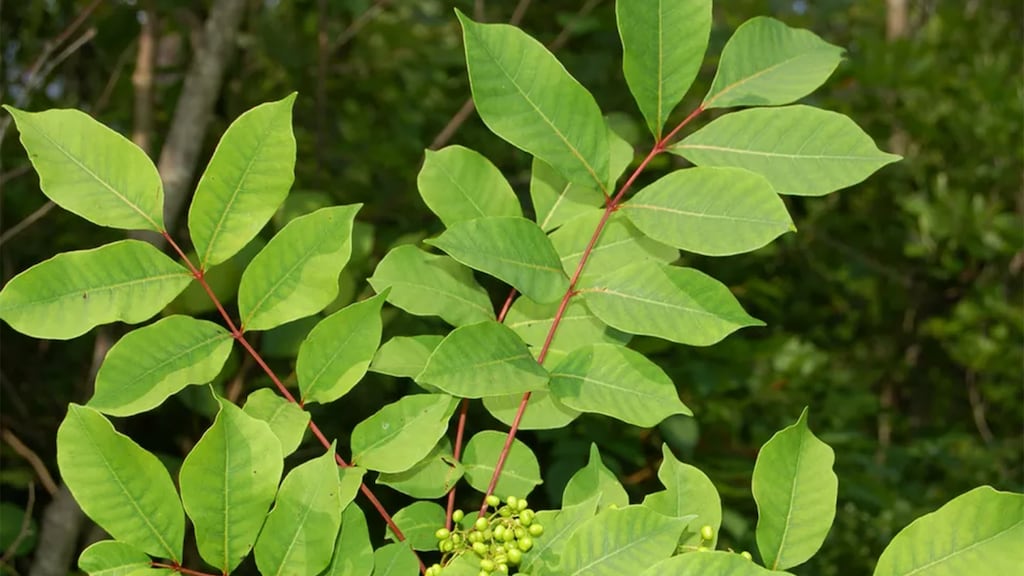
What is poison sumac?
Poison sumac is one of the most toxic plants in North America. When the plant is bruised or damaged it releases oil, called urushiol which causes an allergic skin reaction.
The scientific name of poison sumac is Toxicodendron vernix.
What does poison sumac look like?
Poison sumac grows as a shrub, 10-25 inches (25 to 60cm) tall. Its leaves are elongated, with a smooth velvety texture and a V-shaped point and these are arranged in three to six pairs along a reddish stem with a single leaflet at the end.
Because it is deciduous, its leaves turn red-orange and then are lost in the fall. New leaves in spring are bright orange and later become dark green and glossy. During the spring and summer, small, yellow-green flowers appear in clusters that turn into ivory-white to gray, loosely packed fruits.
Poison sumac likes to grow in swamps and other wet areas but can also be found in pinewoods or hardwood forests. It is particularly abundant along the Mississippi River and swampy areas of the Southeast and common among the eastern and southern quadrants of the United States, although it is not as widespread as poison ivy or poison oak.
Why is poison sumac poisonous?
All parts of the poison sumac plant contain an oily compound called urushiol, which is highly allergenic. Contact with the oil leads to skin irritation and blistering that can last for several weeks. It's particularly dangerous to burn poison sumac because urushiol can aerosolize and cause severe damage to your lungs.
Skin contact with the oil of a poison sumac plant leads to an itchy, burning allergic skin reaction. Poison sumac is considered more allergenic than both poison ivy and poison oak.
What are the symptoms of a poison sumac rash?
The rash begins within 8 to 72 hours of contact in the areas where the plant came into contact with your skin, or where you have touched equipment or pets covered in the oil. Symptoms usually peak within a week but the rash can last as long as three weeks. Some people are more sensitive to the plants and will have harsher symptoms.
The rash looks like patches or streaks of red, raised, watery blisters. It usually stays confined to one area and doesn’t spread unless urushiol is still encountering your skin (from clothes, shoes, or another source).
The rash can be very itchy and burn but scratching should be avoided as this can lead to an infection.
How can I stop a poison sumac rash?
If you know you have made contact with the poison sumac plant, wash the area with cool water and soap as soon as possible. Use rubbing alcohol or alcohol wipes if you don’t have access to water. Keep the area dry and clean. Remove any clothing that may have come into contact with the plant and wash with detergent. Hose down any garden equipment that has made contact.
Although pets are unlikely to develop a rash to poison sumac they can carry the oil on their fur and should be washed after venturing outdoors in areas where poison sumac grows.
The oils in poison sumac remain active even after the plant dies, so be particularly careful when clearing areas of vegetation that may contain poison sumac. Cover your body from head to toe, wear gloves and dig the plant out by its roots and place it into bags to dispose of it. Do not burn it as the smoke from poison sumac contains droplets of urushiol which can severely damage your lungs.
How is a poison sumac rash treated?
Over-the-counter treatments can help relieve the symptoms of poison sumac rash, although they will not cure it. The rash usually resolves in one to three weeks.
Treatments include:
- Calamine lotion
- Hydrocortisone cream
- Cool compresses or baths with baking soda or oatmeal
- Topical anesthetics, such as menthol or benzocaine
- Oral antihistamines, such as diphenhydramine
See a doctor if the rash is on your face or genitals, covers more than 30-50% of your body, if you have a fever, or if your rash has become infected. If you have mistakenly burned poison sumac and have symptoms of lung irritation (such as coughing, difficulty breathing, or wheezing) seek emergency attention as this can be fatal.




